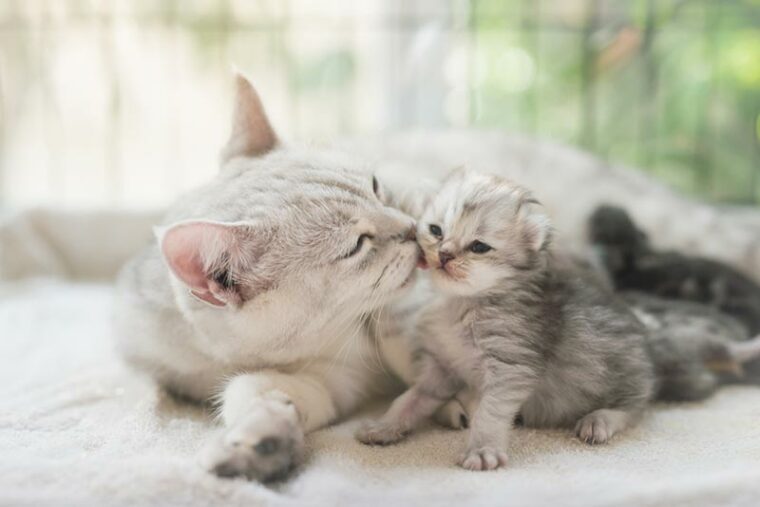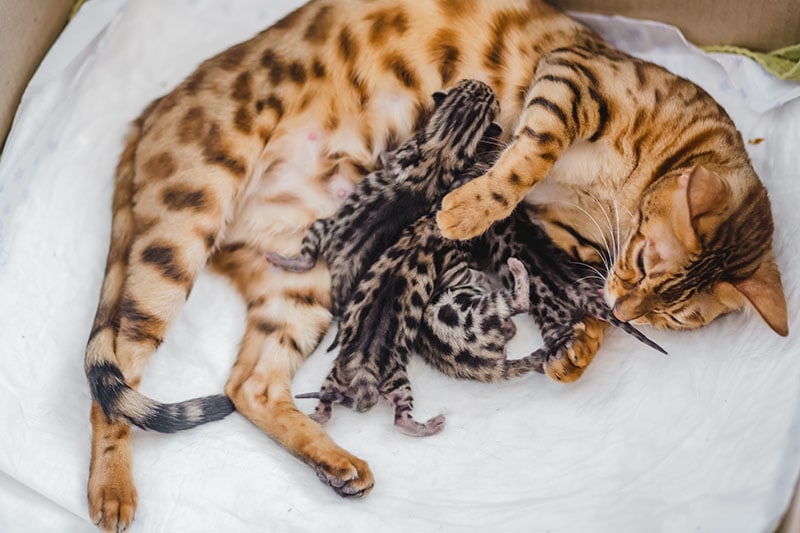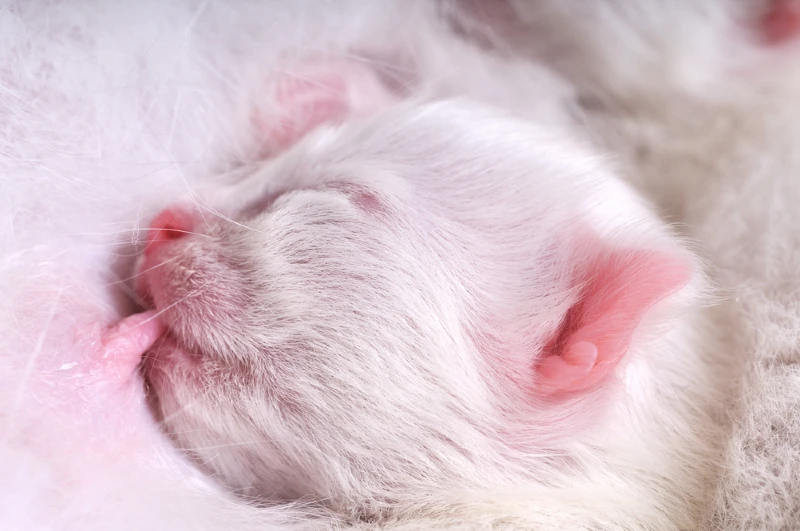
Cats are highly adaptable and resilient animals that have learned to survive in difficult situations. So-called interrupted labor is when pregnant cats that are giving birth can stop their labor process for between 24 to 36 hours. So, sometimes, a cat can be in labor for a few days until the last kitten is delivered meaning that kittens can be born days apart.
Because cats have the ability to interrupt their labor, long periods of time between the delivery of kittens doesn’t necessarily indicate difficulty or complications in labor. However, some other signs may indicate that a pregnant cat needs assistance with delivering her kittens. Here’s what you need to know about a cat’s labor, and when intervening and assisting a cat is an appropriate response.
The Stages of Labor for Cats
A cat’s pregnancy lasts on average between 63 and 65 days , although the range can be 58-75 days.
There are three main stages of labor for cats giving birth. The first stage is the preparation stage, where cats will start to get ready to give birth to their first kittens. This stage usually lasts for up to 36 hours.
During this first stage the cervix and vagina relax. Some cats might experience contractions, but they’re typically weak and come in very brief waves and can usually be felt rather than seen. Cats usually start to get restless and may pace around during this stage with repeated visits to the kittening bed. They may also look for affection and reassurance from their owners.
Once the cat is prepared to give birth, she will enter the second stage. This stage is marked by frequent and stronger contractions. The cat will eventually give birth to her first kitten in this stage, so it’s important to have your cat in a comfortable space where she can deliver its kitten with minimal stress. When cats go through uninterrupted labor, kittens can be delivered between 5 to 30 minutes from each other.
The third stage is the period between kitten births when the mother cat passes the fetal membranes and placenta. In some cases, another kitten will be born immediately after the previous kitten. When this happens, the fetal membranes and placenta of the previous kitten and the following kitten will pass after the following kitten’s birth.

Interrupted Labor in the Third Stage
It’s in this third stage that a cat may have an interrupted labor1. It’s not very clear why a cat can experience interruptions. Sometimes it may be triggered by a disturbance but at other times there is no obvious reason. Some cats may simply want to stop straining and rest.
Cats that have developed a strong bond with their owners may not want to give birth if their owners are not in their sight. So, if the owner were to leave the delivery area, the cat may choose to pause and wait for her owner to return. Other cats will only be happy if they are left alone!
Cats can rest between 24 to 36 hours before they start straining again and resume delivery. Your cat should be resting happily during this time, accepting food and suckling the kittens that have been born.
Therefore, it’s best to be prepared to care for your cat for several days in case it has an interrupted labor.

When to Intervene and Assist Cats in Labor
Since interrupted labor is common in cats, you don’t have to worry too much if the period between kitten births lasts a while. However, cats can experience dystocia2, which is having difficulty giving birth.
Some signs of a difficult birth that mean you should seek immediate veterinary attention include:
Make sure also to be attentive to your cat’s pain level. Mother cats that consistently keep crying out in pain and licking their vulva may be experiencing difficult and complicated labor.

When to See a Vet
It’s best for your cat to go to your veterinarian or an emergency animal hospital to receive the proper care when experiencing difficulty in labor. Labor complications can happen for many reasons such as the kitten being too large or in an abnormal position, or can be due to issues with the mother such as a narrow pelvis after a previous injury. It’s best for her to receive professional help to correct and resume a smooth labor process.
Since it’s important not to add significant stress to the mother cat, make sure to have an emergency crate prepared with blankets and bedding in case you have to transport her to a veterinary care clinic. Preparing all this in advance will prevent you from scrambling to get things ready in a moment of emergency. Make sure also to keep your own actions and emotions in check and be as calm as possible so that your cat doesn’t start to feel anxious.
Conclusion
Cats can spend a little over a day resting in between kitten births. As this interrupted labor is fairly common it’s considered a normal occurrence, so make sure that you are prepared to spend a few days with your cat when she goes into labor. If you sense that your cat is going through any complications, it’s better to be safe than sorry and contact your veterinarian right away. Your veterinarian will be able to help you determine if your cat needs additional care or if she’s doing just fine on her own.
The majority of kittenings are normal and no intervention is needed but make sure to familiarize yourself with the stages of a cat’s labor so you can pick up signs of a problem more quickly. This can help immensely with ensuring that your cat has a smooth labor and that she births a litter of healthy kittens.
See also: How Do You Know When Cat Labor Is Over? 6 Signs to Look For
Featured Image Credit: ANURAK PONGPATIMET, Shutterstock






